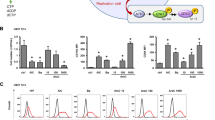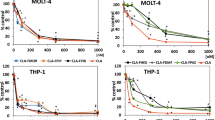Abstract
We have examined interactions between the purine nucleoside analog fludarabine (9-β-arabinofuranosyl-2-fluoroadenine) and the macrocyclic lactone bryostatin 1 in the human monocytic leukemic cell line U937. Fludarabine exerted dose-dependent effects on U937 cell viability and growth which were associated with both induction of apoptosis, as well as cellular maturation. Incubation of cells with bryostatin 1 (10 nM; 24 h) after, but not before a 6-h exposure to 10 μM fludarabine resulted in a modest but significant increase in apoptosis, and was associated with greater than a 1 log reduction in clonogenicity. Subsequent exposure to bryostatin 1 also increased the percentage of fludarabine-treated cells displaying differentiation-related features (eg plastic adherence, CD11b positivity) compared to cells exposed to fludarabine alone. Bryostatin 1 did not increase the retention of the active fludarabine metabolite, F-ara-ATP, nor did it increase 3H-F-ara-A incorporation into DNA. Despite its capacity to trigger cellular maturation, fludarabine exposure (either with or without bryostatin 1) failed to induce the cyclin-dependent kinase inhibitors (CDKIs) p21WAFI/CIP1 and p27KIP1. Nevertheless, dysregulation of p21 (resulting from stable transfection of cells with a p21WAFI/CIP1 antisense construct) reduced fludarabine-mediated differentiation, while inducing a corresponding increase in apoptosis. Enforced expression of Bcl-2 partially protected cells from fludarabine-related apoptosis, an effect that was overcome, in part, by subsequent exposure of cells to bryostatin 1. Interestingly, Bcl-2-overexpressing cells were as or in some cases, more susceptible to differentiation induction by fludarabine (± bryostatin 1) than their empty vector-containing counterparts. Collectively, these results indicate that the antiproliferative effects of fludarabine toward U937 leukemic cells involve both induction of apoptosis and cellular maturation, and that each of these processes may be enhanced by bryostatin 1.
This is a preview of subscription content, access via your institution
Access options
Subscribe to this journal
Receive 12 print issues and online access
$259.00 per year
only $21.58 per issue
Buy this article
- Purchase on Springer Link
- Instant access to full article PDF
Prices may be subject to local taxes which are calculated during checkout
Similar content being viewed by others
Author information
Authors and Affiliations
Rights and permissions
About this article
Cite this article
Vrana, J., Wang, Z., Rao, A. et al. Induction of apoptosis and differentiation by fludarabine in human leukemia cells (U937): interactions with the macrocyclic lactone bryostatin 1. Leukemia 13, 1046–1055 (1999). https://doi.org/10.1038/sj.leu.2401454
Received:
Accepted:
Published:
Issue Date:
DOI: https://doi.org/10.1038/sj.leu.2401454
Keywords
This article is cited by
-
Nucleoside transporters in chronic lymphocytic leukaemia
Leukemia (2004)
-
Requirement for the PI3K/Akt pathway in MEK1-mediated growth and prevention of apoptosis: identification of an Achilles heel in leukemia
Leukemia (2003)
-
New drug development in non-hodgkin lymphomas
Current Oncology Reports (2001)



